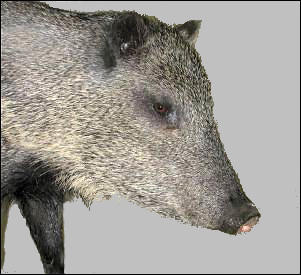The artiodactyls fall nicely into three suborders, the Suiformes (pig-like), Tylopoda (camel-like), and Ruminantia (ruminants). We'll concentrate on regional representatives.
Taxa of the Suiformes in our area include only the Suidae (Old World pigs) and Tayassuidae (peccaries). Both are more or less generalized artiodactyls that are omnivorous. The Suidae is not native to the Western Hemisphere, but has been widely introduced and is feral in our region. Suids have the primitive placental number of teeth with the canines evergrowing. There are four toes on each foot, with the middle two generally being the only ones to touch the ground. The metapodials are not fused. The upper canines grow upward and backwards, as do the lowers.
The Tayassuidae are now limited to the New World (but occurred in the Tertiary in Eurasia) and consist of two or three genera and three species. Members of this family are somewhat more specialized than suids, with a tooth formula of 2/3, 1/1, 3/3, 3/3 = 38. Toes on the hind feet are reduced to three in living forms (to two in some fossil taxa), and the third and fourth metapodials are fused proximally. The two-chambered stomach is more complex than that of suids, but is non-ruminating.
Smithsonian Field Guild: Tayassuidae
 In our region, the Collared
Peccary (Pecari tajacu has, until relatively recently, been absent from the El Paso area and south-central New Mexico. However, they appear to have been spreading more widely in recent
years and now occur in the Hueco Bolson at least are far north as Orogrande and probably to the Alamogordo areas; they also probably are in the Franklin Mountains. Images are available at the
Animal Diversity Web.
In our region, the Collared
Peccary (Pecari tajacu has, until relatively recently, been absent from the El Paso area and south-central New Mexico. However, they appear to have been spreading more widely in recent
years and now occur in the Hueco Bolson at least are far north as Orogrande and probably to the Alamogordo areas; they also probably are in the Franklin Mountains. Images are available at the
Animal Diversity Web.
Collared Peccary (Pecari tajacu). Mounted specimen on exhibit at the Centennial Museum.
Camels underwent most of their evolution in North America, becoming extinct here only about the end of the Pleistocene. Emigration to the Old World and to South America led to the surviving camels (three genera and six species), known as camels in the Old World and llamas and alpacas in the New. Three of the species exist only as domesticates.
Camels have the distal phalanges flat on the ground (encased in a broad pad); the third phalanx bears a nail on the upper surface rather than a hoof. There are two toes per foot, and the metapodials are thoroughly fused (as are the radius and ulna). They have a three-chambered, ruminating stomach. Unlike all other mammals, the red blood cells are oval rather than round.
Last Update: 26 Jan 2008
Centennial Museum and Department of Biological Sciences, The University of Texas at El Paso